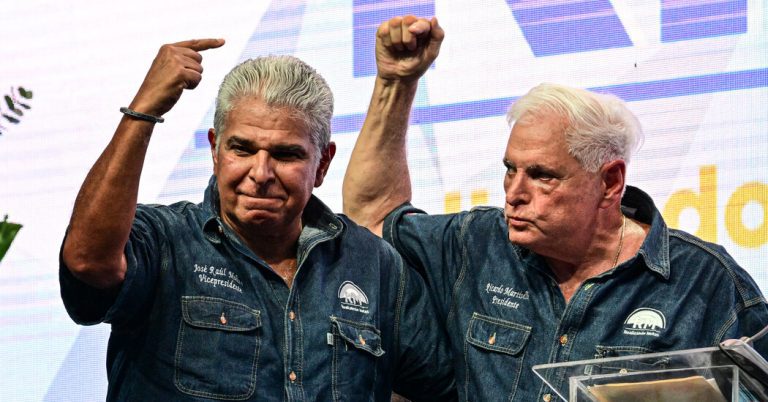Why do these elections matter?
The political crisis has engulfed Panama’s May 5 presidential election, deepening uncertainty in a country grappling with drought and the fallout from widespread protests.
Former President Riccardo Martinelli, who had emerged in the polls as the frontrunner, was barred from running after he was sentenced to 10 years in prison for money laundering. Panama’s Electoral Court allowed its vice president, a former public security minister named Jose Raul Molino, to take his seat. Mr. Martinelli claims he is being politically persecuted.
Mr. Martinelli ruled Panama during a period of strong economic growth and was popular despite his conviction. Mr. Mulino seems to have inherited his following. The result is a paradox: Although Panamanians see corruption as one of the country’s most pressing problems, they have also shown the highest support for Mr. Mulino, who strongly backs Mr. Martinelli.
The election is being held amid great disillusionment with the political establishment. The current president, Laurentino Cortizo, from Panama’s largest political party, is extremely unpopular and has been dogged by corruption scandals. His government has sparked massive protests, with Panamanians paralyzing the country in 2023 to oppose a copper mining contract that critics said would endanger the environment.
Political conflict and social unrest have affected the climate for foreign investment, an area on which Panama relies heavily. In March, Fitch Ratings downgraded Panama’s credit rating, citing the government’s closure of the mine following protests. The country’s gross domestic product growth is expected to fall to 2.5% in 2024 from 7.5% in 2023 as a result of the shutdown, according to the International Monetary Fund.
Who’s running?
Eight candidates are vying for a five-year term in a single-round vote. Panama does not allow sitting presidents to run for a second consecutive term. Panama also elects its representatives to the National Assembly and local governments.
In addition to Mr. Mulino, hopefuls include José Gabriel Carrizo, known as Gaby, who is the current vice president. Martín Torrijos, former president and son of a Panamanian dictator who negotiated for the United States to hand over control of the Panama Canal. Rómulo Roux, former foreign minister; and Ricardo Lombana, former diplomat.
What are the main issues?
A global trade hub, Panama has been one of the fastest-growing economies in the hemisphere, with growth driven by the expansion of the Panama Canal and investors attracted by free trade agreements and the use of the dollar as the local currency. But the next president will have to deal with many fiscal, environmental, immigration and corruption issues.
Panama’s pension system suffers from a high deficit. The economy, which relies heavily on service work, also has a shortage of skilled labor and a large number of informal workers, exacerbating income inequality.
Environmental challenges include a drought that has created low water levels in the canal, resulting in a reduced number of ships being allowed through. The economic impact has so far been limited due to toll increases before the water crisis began, but shipping companies may eventually look for ways to avoid the canal.
Hundreds of thousands of migrants are traveling through Panama’s Darién Gap jungle, creating a humanitarian burden that the next government will have to deal with. Finally, corruption is an ongoing concern, with the high-profile Panama Papers and Odebrecht bribery scandals putting the country in the limelight in recent years.
Who is expected to win?
Polls show Mr Mulino leading by more than 10 points over Mr Lombana, Mr Torrijos and Mr Roux, his nearest rivals. Mr. Molino’s campaign has said that “Molino is Martinelli,” and it is unclear whether Mr. Molino can help Mr. Martinelli’s situation if he is elected president. Mr. Martinelli took refuge in the Nicaraguan Embassy in Panama City after the Supreme Court upheld his conviction this year.
In March, Panama’s Supreme Court said it would hear a challenge to the Electoral Court’s decision to allow Mr. Molino to replace Mr. Martinelli as a presidential candidate. It is not clear when he will rule.
When will we know the result?
The Election Court will provide informal election results after 4:30 p.m. of election day. The winner is expected to be announced that evening.




